Originally prepared for Vegetable MD Online.
This page includes symptoms caused by:
Bacteria
Angular leaf spot | See factsheet for more information (LIHREC)
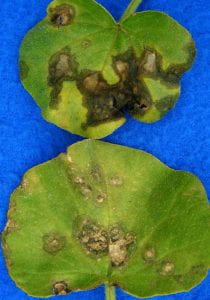
Symptoms: Brown spots, angular in shape (restricted by small veins), often with yellow haloes. Young spots are water-soaked. Older spots have holes in center. Scab causes similar symptoms on leaves. Stems, petioles and fruits develop water-soaked spots that become covered with a white crust.
Bacterial leaf spot | See factsheet for more information (LIHREC)
Symptoms: Leaf spots much smaller than those of Angular leaf spot, and initially may be over looked. The veins do not define the lesion shape, and the yellow margin is indefinite. Fruit lesions vary in size, and may progress into flesh of fruit, causing them to rot.
Bacterial wilt
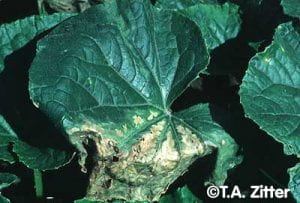
Symptoms: Wilt starts on leaves which then develop interveinal necrosis. The petiole and vine eventually die back.
Fungi & Oomycetes
Alternaria leaf blight | See factsheet for more information (LIHREC)
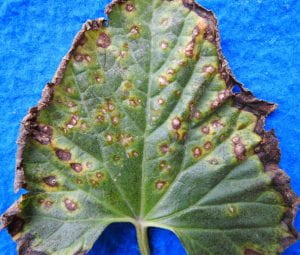
Symptoms: Brown spots, 0.5-5 mm or larger in diameter, with yellow halo. Spots often have concentric rings (target appearance). Uncommon.
Anthracnose | See factsheet for more information (LIHREC)
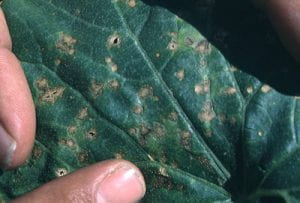
Symptoms: Tan to brown oval spots with pycnidia. Spots may have light centers. Spots on stems and petioles (shallow, elongated, tan) and also on fruit.
Downy mildew | See factsheet for more information

Symptoms: Brown spots, angular in shape (restricted by small veins). Young spots are pale-green then yellow on upper surface. Purplish or gray spores form on under leaf surfaces. Leaves turn brown and die but remain erect, resembling frost injury.
Gummy stem blight | See factsheet for more information (LIHREC)
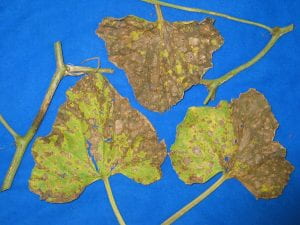
Symptoms: Occasional marginal necrosis and large, wedge-shaped necrotic areas. Yellow haloes may occur. Older spots are often dry and cracked. Spots and streaks on stems, sometimes with gummy exudate. Pycnidia on leaves and stems. Fruit rot phase called black rot. Localized occurrence in region.
Phytophthora rot | See factsheet for more information
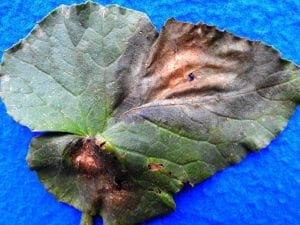
Symptoms: Dark brown leaf spots, up to 5 cm in diameter. Growing tips will likely collapse. Plant decline and fruit rot are more common symptoms. Localized occurrence in field and in region.
Plectosporium blight | See factsheet for more information (LIHREC)
Symptoms: Light tan spots, small, spindle-shaped, sunken, dry, scabby. Spots on main leaf veins and sometimes leaf blades, also on stems, petioles, and sometimes fruit.
Powdery mildew | See factsheet for more information

Symptoms: White, powdery-like spots appearing first on the under surface of older leaves. Also on upper leaf surfaces.
Septoria leaf spot
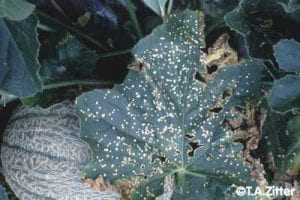
Symptoms: White or beige spots, circular, 1-2 mm or larger in diameter, with narrow brown border. Brown water-soaked spots under wet conditions. Older spots usually are cracked and have a few pycnidia. Fruit symptoms also present.
Scab
Symptoms: Brown spots, angular in shape (restricted by small veins), often with yellow haloes. Young spots are pale-green and water-soaked. Older spots have holes in center. Angular leaf spot causes similar symptoms. Symptoms also occur on petioles, stems and fruit.
Ulocladium
Symptoms: Reddish-brown lesions can reach 6-7 mm in diameter with beige centers surrounded by a darker necrotic ring and brown halo. Lesions are similar in appearance to Angular leaf spot but do not develop the typical “shot hole” appearance.
Phytoplasmas
Aster yellows
Symptoms: Yellowing of young leaves, proliferation of secondary shoots, and rigid, erect growth habit. Fruit symptoms also present. Uncommon.
Viruses
Cucumber Mosaic Virus | See factsheet for more information (LIHREC)
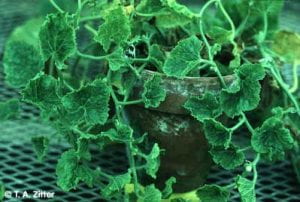
Symptoms: Leaves mottled, distorted, wrinkled, curled, dwarfed. Plant stunted. Fruit symptoms also present.
More information/prepared by:
- For more information, please contact:
Meg McGrath – mtm3@cornell.edu & Chris Smart – cds14@cornell.edu


